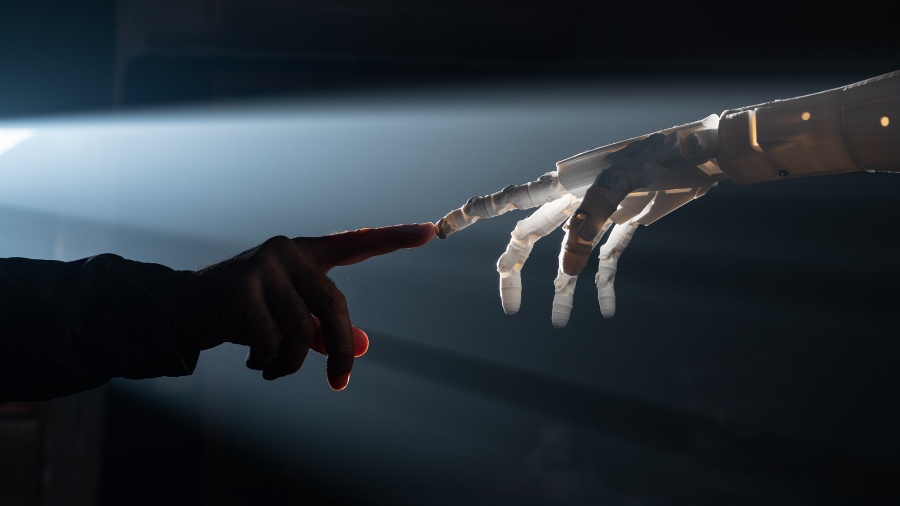AI God: A Perfect Unified Religion?

“What is Truth?” Pontius Pilate asked the one Man who could answer the question completely. The governor walked away without waiting for an answer. The question still vexes our world. Existential feelings override all reality, here in this postmodern world, a place devoid of absolute truth.
In such a world, we seek validation for our values. Enter the new day of AI-spawned religion.
The Early Robotic Faith
Robo-religion showed up first in 2015 when Anthony Levandowski founded “Way of the Future,” a church and religious affiliation with plans to pass all ruling authority from people to cyborgs. He made headlines, but reality caught up to him in 2020, when legal trouble surrounding stolen AI data broiled to the surface.
About the same time “Way of the Future” was being founded, Buddhists also started turning to robotics. “Mindar” is a robo-priest in the ancient temple, Kodaiji. Mindar is not AI powered, but is programmed with a set of sermons repeated to visitors engaging in prescribed Buddhist rituals. “Pepper,” another Buddhist robot priest, was created for funeral chants.
Yuval Noah Harari, world-renowned historian and speaker, recently addressed what he believes should and will happen: a perfect religion to be followed by all in a religiously unified world.
While these examples are merely humanoid computers programmed for specific tasks, the ultimate goal is robots that will evolve and learn with humanity. Tensho Goto, chief temple steward, revealed the future plans:
This robot will never die, it will just keep updating itself and evolving. That’s the beauty of a robot. It can store knowledge forever and limitlessly. With AI, we hope it will grow in wisdom to help people overcome even the most difficult troubles. It’s changing Buddhism.
In Germany, during the 2016 World Reformation Exhibition in Wittenberg, Bless-U2 was unveiled. This robot is little more than a vending machine for blessings, resembling a Christianized version of Zoltar. Bless-U2 is stationary with a digital head to give it the appearance of a person talking.
It also sports two arms to reach out, emit a light, and dole out a blessing. It can speak in either a male or a female voice, as chosen by the recipient. Again, this is all pre-programmed, using nothing from the worshiper except a simple input prompt from a limited number of choices.
These examples are rooted in the idea that religion is about ritual, not about our heart. This is best exemplified by the Hindi robot designed to perform the aarti, a ritual in which a lamp is waved before the statue of a god. Man created a god in an image, then invented a ritual, then created a robot to perform that ritual devoid of human involvement … all to please a statue of stone and metal.
The God of the Bible would not be pleased.
For You do not delight in sacrifice, otherwise I would give it;
You are not pleased with burnt offering.
The sacrifices of God are a broken spirit;
A broken and a contrite heart, O God, You will not despise.
(Psalm 51:16-17, NASB95)
Christianity is about faith, not rituals, chants, or religious works.
Enter AI
To program rituals into a computer is tacky but benign. Artificial intelligence is something else altogether. Do not think artificial intelligence means a machine creates knowledge ex nihilo, as God does. AI searches, compiles information, and often makes things up. The resulting hybrid mosaic of information may seem logical. But is it true?
We need to be aware of how AI works. We use it to seek truth, but AI only drives for an answer.
The primary AI tool leading the pack is ChatGPT. In mere months since its release on the world, it has already made up non-existent cases in a court briefing, falsely declared one political commentator a sexual predator and just as falsely accused another of embezzling.
Still, ChatGPT was the tool used to write and deliver the world’s first AI-powered sermon.
The June 2023 AI service in St. Paul’s church, Fuerth, Germany, featured four AI-generated avatars to deliver this AI-generated speech. It was a perfectly equitable racial and gender balance, and its message centered on leaving the past behind. The sermon and the rest of the church service centered on this prompt: “We are at the church congress, you are a preacher … what would a church service look like?”
The people in attendance liked the service, though with criticisms that the avatars spoke too rapidly and monotonously. But these avatars did not preach a sermon. A sermon should merge the truth of God’s word into the spirit of our hearts. They instead wrote out a church service program that looked just they a service “should” look. It included words of a sermon. But instead of the heart-to-heart preaching that the Bible calls us to (Romans 10:13-17), the robots merely said the words with blank expediency.
The pope has suggested that Catholics can take advantage of robots and artificial intelligence. In November 2020, the Catholic Church officially embraced some of these new technological advances. Pope Francis invited the church to “Pray that the progress of robotics and artificial intelligence may always serve humankind…we could say, may it ‘be human.’”
This may not be as bad is it appears on the surface. The Catholic Church, so far, appears to be looking to technology to advance medicine, education, and humanitarian help. This is in contrast to the Buddhist, Hindu, and even the Protestant Bless-U2 robot, used to shortcut the rituals of God.
Will AI Create the “Perfect” False Religion?
AI does not create. It compiles. It seeks data and responds to the scenario given it. For this reason, using artificial intelligence to lead a church service is more dangerous than using it to identify, say, gaps in educational protocols.
AI does not exclude specific input unless directly instructed to do so. The user can’t know what to exclude from his prompts. So unless you know the latest updates on religions from the Missionary Mobilization Journal, if you ask it to create some religious message, it will include a lot you didn’t intend it to.
Discerning truth from error is difficult in the best of times, and AI is not going to be our savior. If you expect it to produce a perfect religion, you can expect the result to be more deceptive than truthful.
Yet this is exactly where AI is being driven. Yuval Noah Harari, world-renowned historian and speaker, recently addressed what he believes should and will happen: a perfect religion to be followed by all in a religiously unified world.
Harari says, “In a few years, there might be religions that are actually correct. Just think about a religion whose holy book is written by an AI. That could be a reality in a few years.” He believes man-created AI, built not for truth but only for answers, will give us the secrets to all humanity.
Like Pontius Pilate, we look at the truth every day. Our Bible is handed down from tradition. Its word is accurate, its truth supported by history, science, archaeology, and critical review. Our Bible is as faithful today as when the inspired hand of the prophets and apostles wrote its books.
We could take up the mantle of sitting down quietly with God and our Bible. Instead we seek easy answers from man-made computers. Easy? Yes. But deceptive.
Tom Murosky is the creator of Switched to Linux, a Free and Open Source Software teaching channel with over 12 million views. He also teaches on Christian living at Our Walk in Christ, and has published several books including Hezekiah’s Prayer. Tom has a B.S. in biochemistry from Edinboro University of Pennsylvania and his doctorate in molecular toxicology from Penn State University.


